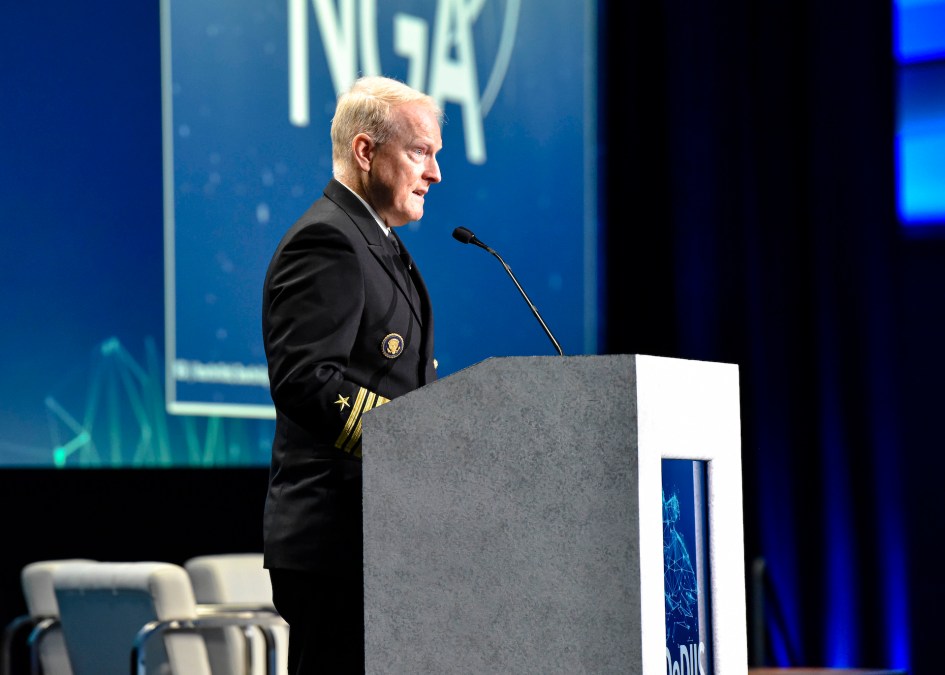The year of ‘NGAI’: Geospatial-intelligence agency looks to accelerate AI adoption in 2025

COLORADO SPRINGS, Colo. — The National Geospatial-Intelligence Agency is making adoption of artificial intelligence and machine learning capabilities a primary focus in 2025 by integrating new technologies into its workflows.
As a combined intelligence and combat support agency, NGA is tasked with collecting geospatial intelligence (GEOINT) from satellites and other sources and turning it into actionable data for military operators and decision makers. Although the organization is already well-versed in AI capabilities — as it runs the Pentagon’s high-profile Maven computer vision program — NGA Director Vice Adm. Frank Whitworth is pushing personnel to leverage the technology even more this year.
“As I was looking at the last several years, we use descriptors for the ‘A’ in NGA with a little bit of alliteration, and we would say ‘action’ or ‘acceleration,’” Whitworth told DefenseScoop in an exclusive interview on the sidelines of Space Symposium. “I wanted to put a finer point on it and say, the ‘A’ for this year is going to be AI.”
Research from NGA and industry on multimodal artificial intelligence has been one of the key factors driving his push for acceleration, he noted.
Similar to generative AI, multimodal models can simultaneously process information from multiple source types — including text, images and audio. But while generative AI is geared toward creating new content, multimodal AI expands on those capabilities and allows users to understand different types of data in a single, integrated output.
For NGA, that could mean creating more holistic intelligence packages from sources beyond just imagery, which will be critical as available data is expected to exponentially increase in the coming years due to new sensors being fielded across domains.
“Distinction is really difficult — to distinguish enemy from non-enemy, combatant from non-combatant,” Whitworth said. “While GEOINT, imagery-derived intelligence typically is one of our primary forms of identifying and driving distinction, we always are looking for other forms of corroboration.”
NGA has already employed three test cases for multimodal AI, although Whitworth said the capabilities are still too early-on in their development to talk about them more specifically. However, he emphasized that the agency continues to explore other ways to collect and verify data beyond computer vision.
“It’s a big Earth, and so while we have really good indications typically of where to look, there’s no guarantee,” he said. “Our business is to steal secrets, and when people are trying to keep things secret from us that could cause us harm or change the American way of life, we’re going to have to rely on all kinds of sources to ensure we’re looking at the right place.”
NGA also intends to leverage lessons from ongoing AI-focused targeting programs like Maven and apply them to its other roles, such as warning — which Whitworth described as a “behemoth” responsibility.
“Warning involves establishing a baseline of equipment, behaviors, activities around the world and being able to prioritize where you’re looking, and then ensuring you can find anomalies and announce them,” he said. “That’s going to take a lot of work. … Warning requires improvements in workflow, improvements in automation and yes, it will involve AI and ML.”
The warning mission is currently under the purview of the agency’s Analytic Services Production Environment for the National System for GEOINT program, also known as ASPEN, Whitworth said.
Kickstarted in 2023 to address massive increases in data, ASPEN is a suite of analytic capabilities that leverages automation and AI to help NGA analysts provide more accurate warning indications to customers.
In order to streamline adoption of AI across all of its roles and responsibilities, Whitworth noted that NGA has recently established a new program executive office for advanced analytics helmed by Rachael Martin, who previously served as the program lead for NGA Maven. The PEO intends to bring together the agency’s best practices of artificial intelligence and machine learning.
The new office is NGA’s latest organizational change made to help its AI adoption in 2025. The agency also recently named Mark Munsell as its first director of AI standards, while Trey Treadwell and Joseph O’Callaghan are serving as director of AI programs and director of AI mission, respectively.
“We didn’t actually have people who came to work and said, ‘I am the director of AI.’ And it was time to do that,” Whitworth said. “As the organization begins to mature, you at least have somebody who’s thinking about, what do I need in my organization? Do I need to change names? Do I need to change the organizational structure to ensure AI/ML is treated with the seriousness it deserves?”
At the same time, NGA is keeping an eye out for AI-enabled capabilities being developed by the commercial industry that could be incorporated into its workflows, while leveraging innovative procurement methods geared towards commercial solutions, Whitworth said.
For example, the agency used the Defense Innovation Unit’s commercial solutions opening (CSO) process to award pilot funding for Project Aegir, a program that focuses on commercial techniques to identify, monitor and track illicit maritime vessel activity in the U.S. Indo-Pacific Command area of responsibility. NGA is also exploring using bailment agreements, which allows the Defense Department to temporarily loan government-owned systems to smaller companies in order to test, research and develop new capabilities during a trial period.
“It is really focused on, how do we get industry into the door quickly? That’s why we did things like the CSO, that’s why we’re trying bailment agreements,” Whitworth said. “We’re leaning forward on trying to bring them in, because industry moves at the speed of light.”






